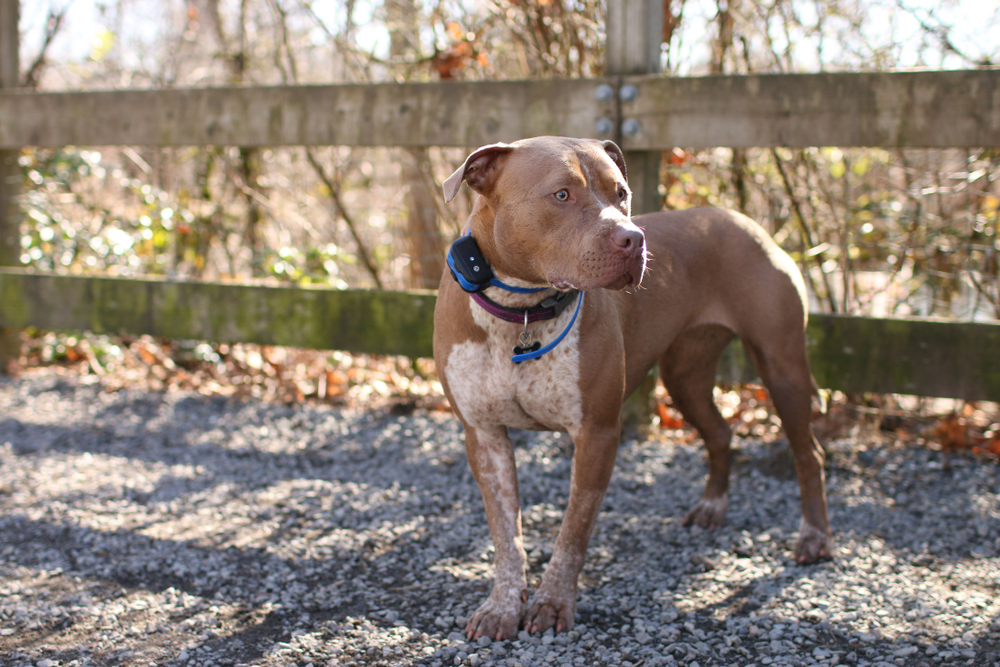In this article
There are many valid reasons to contain your dog on your property, including keeping your pet safe and maintaining good neighborly relationships. Letting dogs run loose can result in things like injuries, attacks on humans, dog fights, vehicle accidents, and property damage. So, it makes sense that you want to do what you can to keep your dog in your yard.
If you’ve heard of invisible electric fences, you might be wondering whether one would work for your pet. The answer isn’t cut and dry: An invisible electric fence may work for your dog, but it is considered an aversive training method, and discouraged by veterinary associations around the world. Read on to learn how these fences work, whether they could hurt your pet, and their pros and cons.

How Do Invisible Electric Fences for Dogs Work?
As the name suggests, an invisible electric fence utilizes invisible signals to create a barrier around a specific area of land. Wired and wireless versions are both available on the market. Wired systems require you to place wires under the ground wherever you want to create a barrier. For example, you can place them in a square pattern to create a traditional “fenced-in yard.”
The wires emit radio signals to a collar that the dog is wearing, which will react accordingly. In general, when a dog gets too close to the fence border, the collar will emit a beeping noise as a warning. If the dog ignores the warning and goes farther toward the fence line, a vibration or, more commonly, a shock will be released from the collar to create an unpleasant experience. The idea is for your dog to heed the beeping warnings and never get close to the fence line.
Wireless systems work in the same way but use wifi to create the boundaries, as set on a mobile app. No wires need to be placed underground, so the transmitter creates invisible boundaries. When those boundaries get pushed, the transmitter and collar deliver the aversive stimuli.
As you can see, these invisible fences work on the principle of punishment; they deliver an aversive stimulus for the undesired behavior.

Do Electric Fences Hurt Dogs?
In order for these invisible fences to work, the dogs need to find the consequences unpleasant enough to avoid. Since the shocks and vibrations work to deter dogs, we know that they do hurt dogs. In addition, the aversion needs to be strong enough to counteract a dog’s natural instincts like prey drive and territorial behavior. However, an intact male might break training to pursue a female in heat, and a dog with a strong prey drive might also break training in the hopes of catching a squirrel.
While these products are not designed to do bodily harm to a dog, negative behavioral consequences are common due to the anxiety caused by the aversive stimulus. Wounds and uncontrolled electrical shocks can occur from poorly fitted or malfunctioning collars. Dogs can also misinterpret the beep from other devices as an oncoming electric shock and react fearfully.
Some dogs respond better than others to the use of electric fences. While some respect the boundary after one or two bad experiences, others will push boundaries and even tolerate electric shocks in order to ignore the invisible fence line.
Multiple veterinary associations around the world have issued statements about the use of shock collars, and similar products:
- The American Veterinary Medical Association (AVMA): Does not discuss the use of invisible fences. Advises that punishment is not an appropriate first-line treatment due to the negative effects of punishment, including fearfulness and aggression.
- The British Veterinary Association (BVA): Has lobbied with the government to ban the use of shock collars in England, with legislation being in the works since April 2023. The BVA calls out their use for containment specifically, stating that if they are used the boundaries should be visible or audible to dogs and cats. They do not support the use of hidden fences that require animals to learn where the boundaries are. They want the sale of electric containment fences to occur only through approved vendors following certain guidelines.
- The Australian Veterinary Association (AVA): Acknowledges that there are times when an invisible fence can increase the safety and welfare of an animal, and supports responsible use in these situations. They are the only form of shock collar allowed in New South Wales. They recommend visible boundary markers, and this is enforceable by law in some states. The AVA believes the audible sound that precedes a shock becomes a threatening stimulus and is unpredictable to the animal, who experiences uncertainty and anxiety.

What Are the Pros of Electric Fences for Dogs?
There are some benefits to the use of invisible fences over traditional fencing, however, these benefits are for humans and not for dogs. If you are considering the use of invisible fence containment collars, ask yourself if these benefits outweigh the cons and, if you are able to use them in a way that maximizes your pet’s welfare as the first priority.
- Affordability — Traditional fencing simply costs more to install and maintain than invisible fencing.
- Easy Adaptation — Traditional fencing cannot effectively be installed on all types of terrain, but electric fences are adaptable enough to do so. They can be used on hills, in wooded areas, and wherever the land is harsh.
- Invisibility — The fact that electric fences are invisible can be beneficial if you want to maintain a clean look for your property and you don’t want to inhibit the view from your home in any way.
- Perception of Protection — An unscrupulous person who sees a dog hanging out in the yard without any perceived borders is not likely to spend enough time nearby to figure out how to break into your home later.
What Are the Cons of Electric Fences for Dogs?
While there are some positive things to consider about electric fences, there are also plenty of negative aspects. For one thing, you can’t just let your dog outside and expect an electric fence to be successful like a traditional fence would. You have to show your dog the perimeter of the fence line and teach them what the beeping noise coming from the collar means. Most products provide training materials to work with. Here are other important cons to consider:
- Anxiety and Poor Behavior — Some dogs can get anxious from a lack of understanding of where the perimeter of the electric fence lines is, and repeated exposure to aversive stimuli. Even if they do determine where it is, they may get agitated when they see other dogs and people moving freely outside of the perimeter where they can’t go. This frustration can lead to behavior problems and cause issues that you didn’t have to deal with before.
- Lack of Protection — Your dog may not be able to get out of your yard, but that doesn’t protect them from intruders. If a loose dog decides to attack, they can do so freely, as there is no barrier for them to worry about. An electric fence also won’t keep humans from coming to your property and causing harm to your dog or belongings.
- Lack of Reliability — Compared to traditional fencing, electric fences are not highly reliable. If the power goes out, so does the electric fencing system. If the batteries in your dog’s collar die, the fence won’t do any good.
- Sudden Escapes — Electric fences are not foolproof, so a dog can escape at any given time for various reasons. The system might go down or fail, even if just temporarily, allowing for an easy escape even if unintentional. Also, some dogs might decide to override the barrier system, cope with the shocks, and head out to the street when something worth investigating appears.

Will an Electric Fence Work for Your Dog?
An invisible fence can work when a dog has the right temperament and is trained appropriately to be able to avoid the aversive stimuli from the containment collar. However, without proper training, dogs feel out of control and threatened which leads to behavioral problems. Older dogs with cognitive decline may not be able to learn the “rules” of the new system well enough to avoid adverse effects. In addition, certain dogs will override the fence boundaries. In this circumstance, some owners might be tempted to increase the power of the shocks, but we don’t recommend doing this for animal welfare reasons.
If your dog appears to be overriding the barrier or not learning how to avoid the shocks, talk to an animal trainer to get their recommendations. Or better yet, install some traditional fencing to safely contain your dog.
What Are the Alternatives to Electric Fences for Dogs?
The only real alternative to electric fences is traditional fencing. However, if that’s not an option, there are alternative restraints that you may be able to employ. For example, consider using a long lead when taking your pup outside so they stay in the yard but still have a sense of freedom. You can tie the lead to a tree or another sturdy object when you’re spending time barbecuing or doing other outdoor activities so your dog can freely interact with you. Never leave your pup outside on a lead unsupervised, though, as it can lead to serious injuries or strangulation.
If your dog is a small breed, you can use a toddler playpen that doesn’t have a bottom to let your pup have a bit of freedom and fun outside. Another option is to install chicken wire or netting along the barrier of the space that you want to keep your dog in and train them to stay within the visible barriers, but this option requires constant supervision while in use. Your best bet is to budget for a traditional fence.

Conclusion
Whether an electric fence is right for your dog depends on various factors: How does your dog react to the system? Are there stray dogs and other threats present in your neighborhood that could infiltrate your property? Do you have reliable electricity service? Are you worried about the system hurting your dog? What does your veterinarian think about the idea of using an electric fence for your dog in particular?
Take the time to answer these questions before making a final decision about setting up an electric fence for your dog. And if you do think an electric fence is the way to go, please ensure your dog gets proper training to learn how this system works.
Featured Image Credit: Sarah Ros, Shutterstock




















2 Responses
I am totally against electric fences for dogs. But my son_law say that the dogs get "used to the elect "fences, hence they're not worth the $ money. He hasn't a clue what it does to the dogs.
Hi Brenda,
Thank you for sharing your thoughts. You make a really important point, many people don’t realize how aversive electric fences can be for dogs, both physically and emotionally. They can cause stress, confusion, and fear, especially if a dog doesn’t understand why they’re being shocked.
It’s clear you care deeply about dogs’ well-being, thank you for speaking up for them.